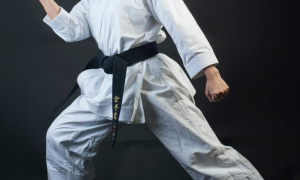
If you want to begin your karate journey but can’t commit to regular dojo classes, learning karate at home is a very viable option with the right dedication and preparation. While it presents unique challenges without direct instructor supervision, today’s online resources allow you to gain real proficiency in karate fundamentals, kata, self-defense techniques, and conditioning from the comfort of your living room.
Table of Contents
ToggleIs It Truly Possible to Learn Karate at Home?
With access to online karate lessons, training videos, books and solo drills, you can absolutely start learning proper karate skills and knowledge entirely from home. However, an in-person instructor provides personalized feedback and corrections that are difficult to replicate solo. You’ll need to be honest in analyzing your own technique.
The Pros and Cons of At-Home Karate Training
| Pros | Cons |
|---|---|
| Convenience – Practice on your own schedule | Limited Feedback – Harder to spot and fix errors |
| Affordability – Avoid membership fees | Injury Risk – More dangerous without supervision |
| Self-Paced Learning – Progress at your own speed | Motivation Difficulties – No community support/accountability |
| Builds Discipline – Requires dedication without instructor | Plateaus – May reach skill ceilings without new instruction |
If you pursue home karate training, be honest with yourself, train carefully, join online martial arts communities for feedback and be prepared to supplement with occasional in-person lessons.
How to Learn Karate at Home – Essential Training Resources:
With the wealth of instructional material available today, everything you need to build real karate skills at home is at your fingertips:
Online Karate Classes
Structured video courses like those on Udemy allow interactive learning and instructor feedback. This gives you rankings, structured progression and student community support lacking in self-guided programs.
Instructional Karate Videos
Free YouTube channels paid platforms offer step-by-step technical breakdowns on kata, self-defense applications, pad/bag work and sparring drills. Pausing and re-watching allows you to absorb proper form and mechanics.
Books and Manuals
Reference guides cover history, terminology, stances, techniques and detailed kata diagrams. Textbooks allow self-paced study and retention of core principles. They also provide foundational context on karate’s origins and evolution.
Solo Home Training Drills
Beyond instructional content, optimize solo sessions to better learn karate at home with targeted drills:
- Kata Training – Reinforce techniques and principles by rehearsing kata.
- Shadowboxing – Hone form, speed and visualization without contact.
- Kickboxing Workouts – Combine skills with cardio/strength conditioning.
- Target Pads – Develop speed and accuracy striking pads held or mounted.
- Sparring Equipment – Train safely solo using padded sticks, shields, and heavy bags.
- Stretching/Meditation – Stretching cultivates flexibility. Meditation helps with balance and mental focus.
How to Learn Karate at Home – Sample Weekly Training Schedule
To make consistent progress learning karate at home, structure a weekly training schedule targeting different skills. For example:
| Day | Focus | Duration |
|---|---|---|
| Monday | Kata practice & shadowboxing | 30-45 mins |
| Tuesday | Heavy bag drilling | 30 mins |
| Wednesday | Stretching & conditioning | 30 mins |
| Thursday | Online video lessons | 45-60 mins |
| Friday | Self-analysis & review | 30 mins |
| Saturday | Sparring drills | 30 mins |
| Sunday | Rest Day | – |
Listen to your body and adjust for needed recovery. But regular training develops crucial martial arts habits.
Karate Training at Home for Beginners – Gear
While extensive equipment isn’t essential early on, some basic karate gear makes learning karate alone much more effective:
| Equipment | Description |
|---|---|
| Training mat | Cushioned mat to practice falling/rolling |
| Heavy bag | For punches, kicks, combinations |
| Kick shields | Padded target to hold for kicking |
| Focus mitts | For a partner to wear to practice strikes |
| Target pads | Held targets for speed, accuracy |
| Foam sticks | Safe sparring equipment |
| Mirror | Check form and technique |
These affordable basics go a long way in transforming an empty garage or basement into a karate dojo.
Basic Karate Skills for Beginners at Home
If you’re starting your journey as a karate white belt from the comfort of your home, resist the urge to dive straight into advanced techniques. Lay a strong foundation by mastering the fundamentals first. Here are the key elements to focus on as a beginner:
Stances
Stances provide the bedrock of stability and balance in karate. Embrace a variety of stances to enhance your versatility:
| Stance | Purpose |
|---|---|
| Front Stance | Balance and basic mobility |
| Back Stance | Defense and counterattacking positioning |
| Horse Stance | Lower body strength and stability |
| Cat Stance | Swift transitioning and quick directional changes |
| Twist Stance | Generating power in strikes |
| Transitional Stance | Seamless movement between other stances |
Blocks
Mastery of blocks safeguards you against incoming attacks. Practice these different types of blocks:
| Block Type | Usage |
|---|---|
| Low Block | Defending against lower body strikes |
| Middle Block | Guarding against torso-level attacks |
| High Block | Shielding from high-reaching strikes |
| Circular Block | Intercepting attacks in circular motion |
Strikes
Effective strikes are your offensive arsenal. Develop precision and power in various strikes:
| Strike | Application |
|---|---|
| Front Punch | Quick and direct attack |
| Reverse Punch | Powerful straight punch from the rear |
| Spear Hands | Targeting vital points with fingers together |
| Palm Heels | Close-range strike with the base of the palm |
| Hammer Fists | Forceful strikes using the fist’s bottom |
| Backfists | Strikes with the back of the hand |
Kicks
Kicks enable you to strike from a distance and maintain control. Explore these kicks:
| Kick | Purpose |
|---|---|
| Front Kick | Swift kick targeting the opponent’s midsection |
| Roundhouse Kick | Circular kick with potential for powerful impact |
| Side Kick | Horizontal kick striking with the side of the foot |
| Axe Kick | Descending strike using the heel |
| Snap Kick | Quick and sharp kick with snapping motion |
| Spinning Kicks | Dynamic kicks executed during a spin |
Kata
Kata, a choreographed sequence of movements, embodies the essence of karate. Begin with these foundational kata:
- Taikyoku: Simplicity and basics.
- Heian/Pinan: Progressively complex sequences.
- Bassai Dai: Strong, aggressive movements.
- Empi: Focus on sharp turns and quick techniques.
Conditioning and Mindset
Karate demands not only physical strength but also mental resilience. Incorporate these aspects into your training routine:
- Knuckle Pushups: Strengthen your wrists and knuckles.
- Meditation: Foster mental focus and clarity.
- Stretching: Enhance flexibility crucial for martial arts performance.
Remember, your journey in karate is a blend of discipline and discovery. Develop a routine that respects your current abilities while progressively pushing your limits. Through consistent practice, you’ll forge a path to mastery.
“In the beginner’s mind there are many possibilities, but in the expert’s there are few.” – Shunryu Suzuki
Ingraining proper technique in stances, breathing and hip rotation should take priority over increasing power during early training. Check form frequently in a mirror.
Progressing Beyond Karate Basics At Home
Once fundamentals feel solid after consistent practice, you can gradually advance your skills training solo:
- Learn more complex kata – Jitte, Kanku Dai, Hangetsu, Bassai Sho, etc.
- Increase technique speed, power and combinations.
- Develop greater kicking flexibility, height and balance.
- Practice leverage, sweeps and throws for self-defense.
- Spar carefully against bags, shields and padded sticks.
- Use ankle weights, and resistance bands to build martial arts-applicable strength.
- Research advanced concepts like strategic fighting, pressure points and joint locks.
- Supplement with tennis ball drills, and stickwork targeting reflexes.
Realistic Timeframe for Learning Karate Basics From Home
How long does it take to learn karate fundamentals training on your own? With consistent, dedicated practice:
- 3-6 Months – Comfortable with basic techniques, stances and kata.
- 6-12 Months – Developing intermediate power, precision and form.
- 1-2 Years – Building advanced skills but with room for improvement.
To optimize progress:
- Train 30-60 minutes daily, at least 5 days per week.
- Prioritize meticulous technique over speed/power early on.
- Increase intensity gradually under controlled conditions.
- Film training to monitor areas needing improvement.
- Stick to a structured video/book curriculum when possible.
- Stay patient – proficiency takes years, so accept gradual progress.
Enjoy the lifelong journey! Karate can’t be fast-tracked, but bring consistent effort.
Frequently Asked Questions on Learning Karate at Home
How Difficult is Karate to Learn on your own?
Like any complex endeavor, expect challenges. But with the abundance of instructional material available and a step-by-step approach, karate fundamentals can be learned solo with proper dedication. Just don’t rush the process.
What Home Training Equipment is Absolutely Necessary?
At a minimum, a training mat for safe practice. Target pads and kick shields allow the developing of proper striking mechanics. A heavy bag eventually becomes essential too. Basic gear improves solo sessions immensely.
Can you truly Learn Karate via Online Classes alone?
It’s not quite equal to in-person training under a black belt but certainly better than self-guided learning. Accredited online programs with interactive instruction, feedback and progression get you surprisingly close to the real dojo experience.
How do I stay Motivated to Learn Karate at Home alone?
Schedule training sessions well in advance to build habits. Record videos to monitor improvements. Join online martial arts communities and forums to connect with others. Remember your “beginner’s mind” and stay fascinated with karate as an endless journey.
While self-driven karate practice at home certainly has unique challenges, the rewards of improved mind-body awareness, self-mastery and lifelong learning make it well worthwhile. With the right tools and mindset, you can start living your karate dream today no matter your current circumstances or limitations. Osu!


